MGL1112 Business and Legal Environment Report: Case Study Analysis
VerifiedAdded on 2022/12/23
|11
|2672
|78
Report
AI Summary
This report addresses three key areas of business and legal environment: tort law, employment status, and workplace health and safety regulations. The first section analyzes a case study on tort law, focusing on negligence and the requirements for establishing a duty of care, referencing the Caparo test and the case of Donoghue v Stevenson. It examines whether a shopping center can be held liable for negligence and discusses potential defenses. The second section delves into employment law, exploring various tests like the control test, integration test, and multi-factor test to determine an individual's employment status, with references to relevant case laws such as Stevens v Brodribb Sawmilling Co Pty Ltd and Humberstone v Northern Timber Mills. The final section examines workplace health and safety regulations in Australia and NSW, outlining the responsibilities of employers under the Work Health and Safety Act and relevant regulations, including the duties to identify and manage risks. The report provides a comprehensive overview of these critical legal aspects within a business context.
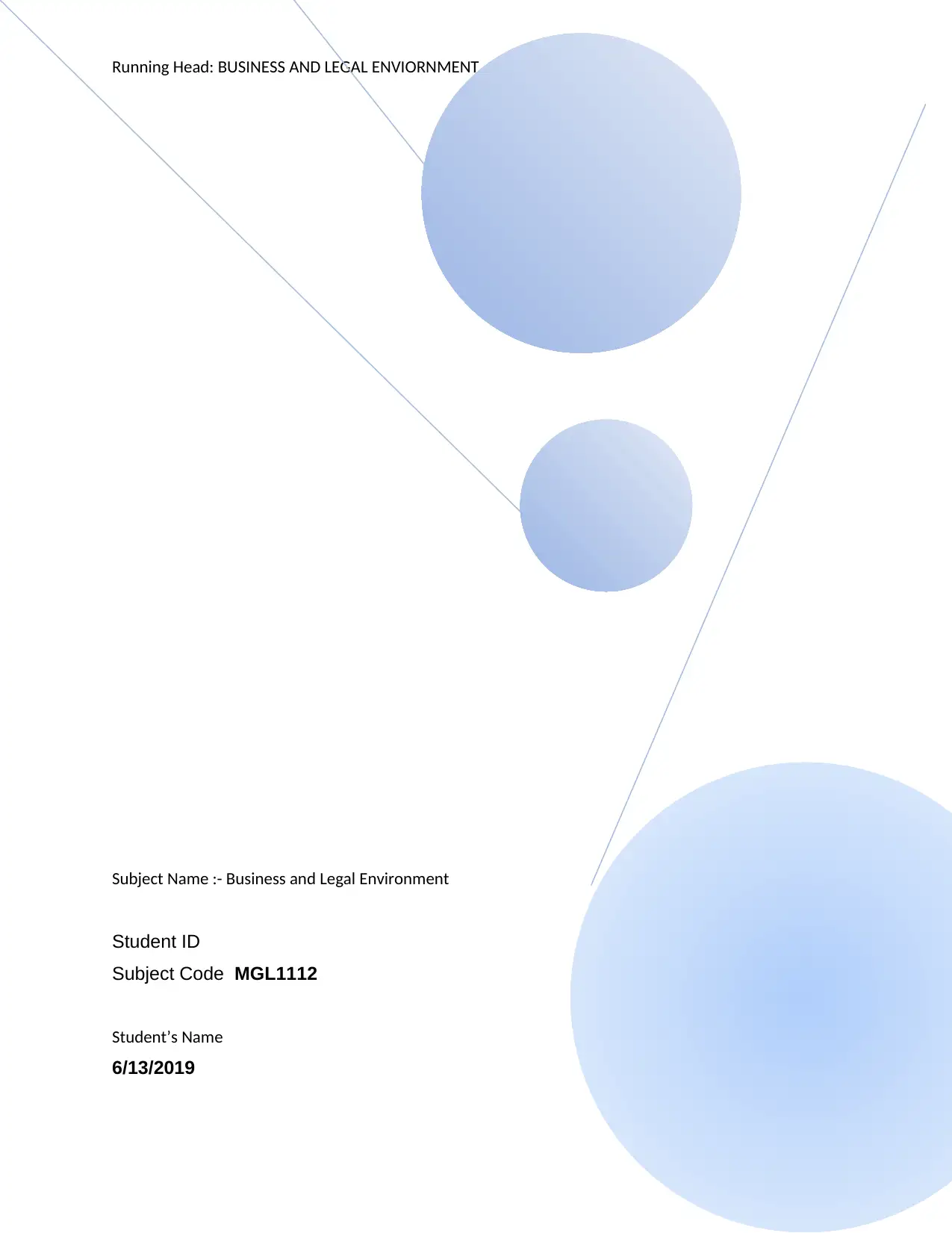
Running Head: BUSINESS AND LEGAL ENVIORNMENT
0
Subject Name :- Business and Legal Environment
Student ID
Subject Code MGL1112
Student’s Name
6/13/2019
0
Subject Name :- Business and Legal Environment
Student ID
Subject Code MGL1112
Student’s Name
6/13/2019
Paraphrase This Document
Need a fresh take? Get an instant paraphrase of this document with our AI Paraphraser
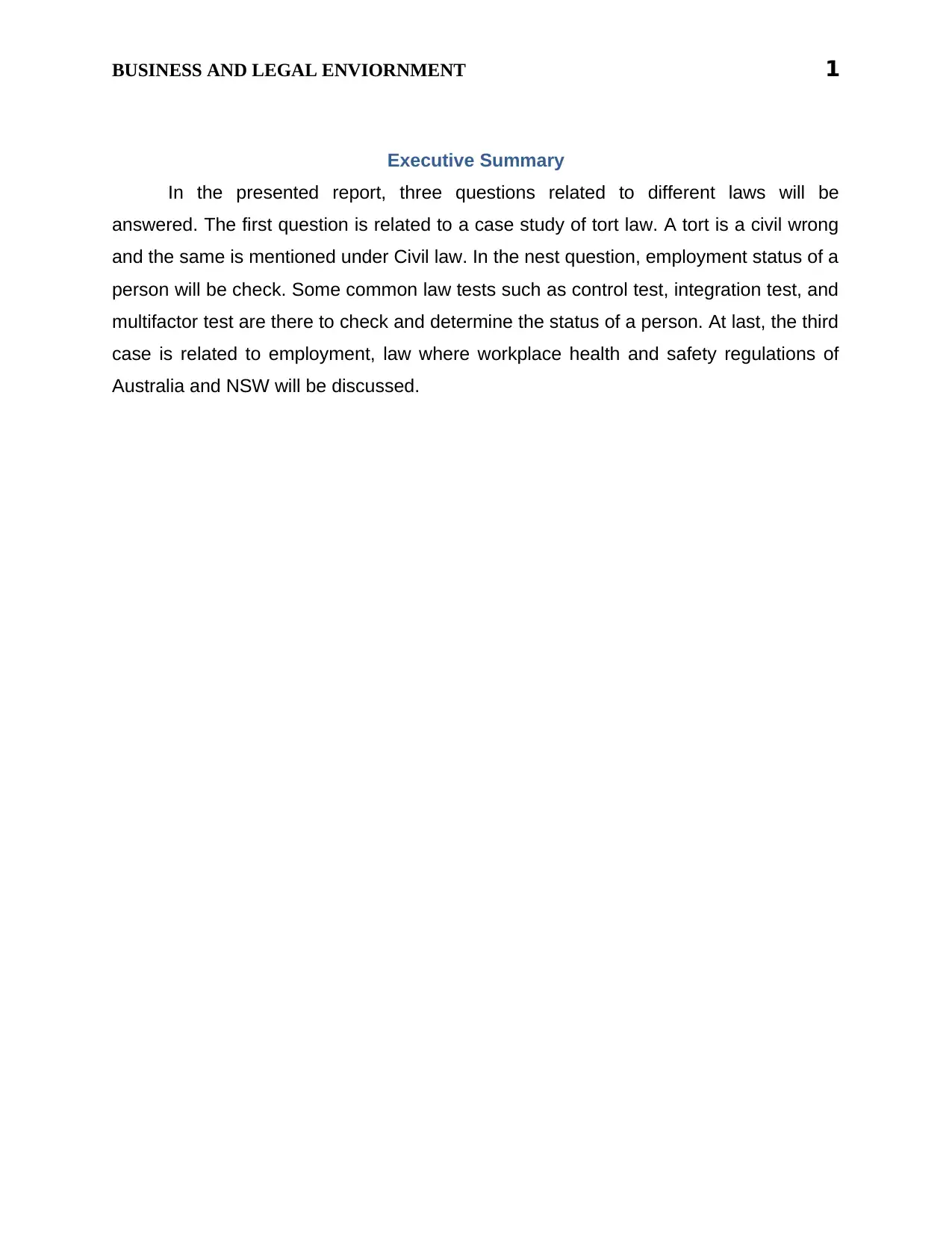
BUSINESS AND LEGAL ENVIORNMENT 1
Executive Summary
In the presented report, three questions related to different laws will be
answered. The first question is related to a case study of tort law. A tort is a civil wrong
and the same is mentioned under Civil law. In the nest question, employment status of a
person will be check. Some common law tests such as control test, integration test, and
multifactor test are there to check and determine the status of a person. At last, the third
case is related to employment, law where workplace health and safety regulations of
Australia and NSW will be discussed.
Executive Summary
In the presented report, three questions related to different laws will be
answered. The first question is related to a case study of tort law. A tort is a civil wrong
and the same is mentioned under Civil law. In the nest question, employment status of a
person will be check. Some common law tests such as control test, integration test, and
multifactor test are there to check and determine the status of a person. At last, the third
case is related to employment, law where workplace health and safety regulations of
Australia and NSW will be discussed.
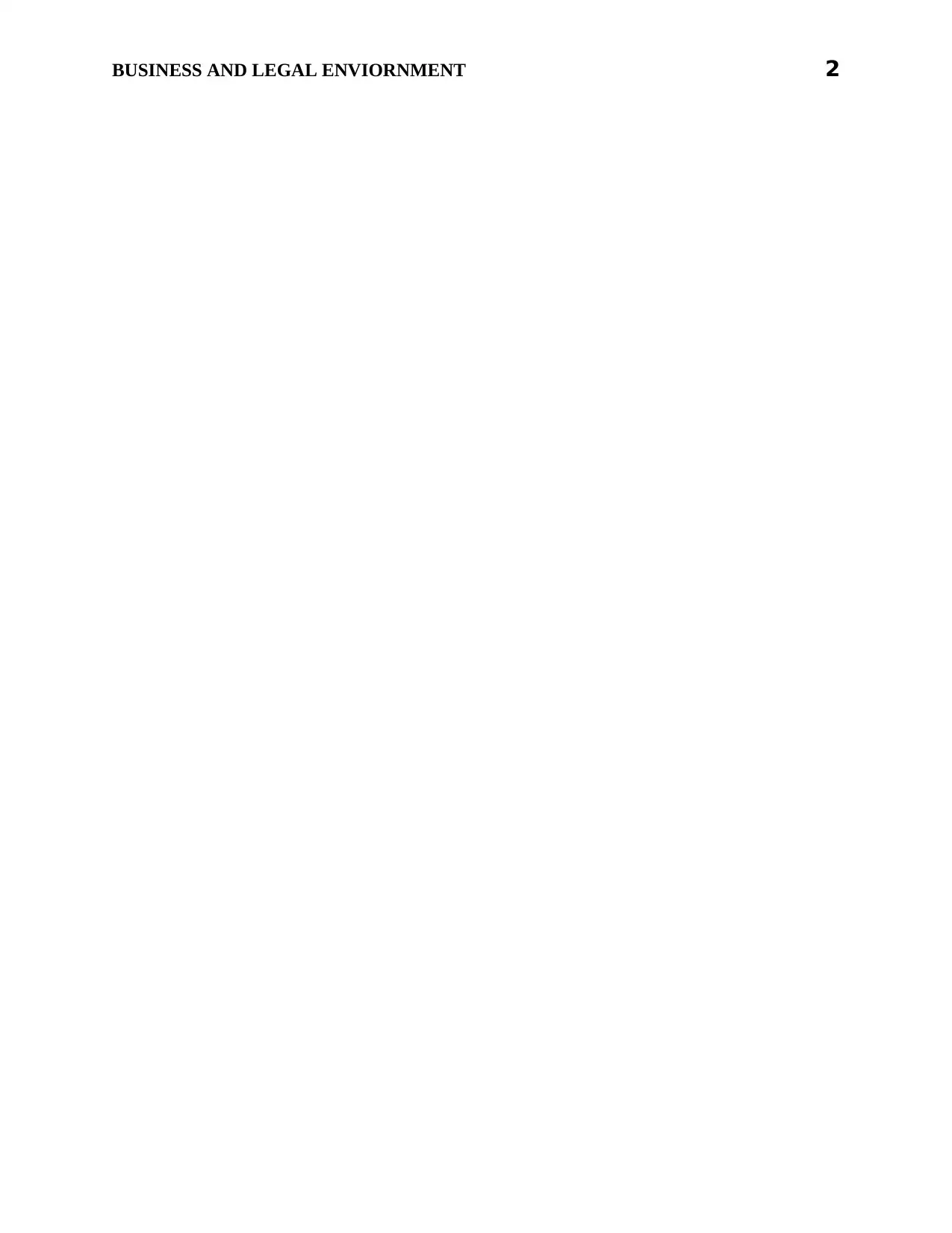
BUSINESS AND LEGAL ENVIORNMENT 2
⊘ This is a preview!⊘
Do you want full access?
Subscribe today to unlock all pages.

Trusted by 1+ million students worldwide
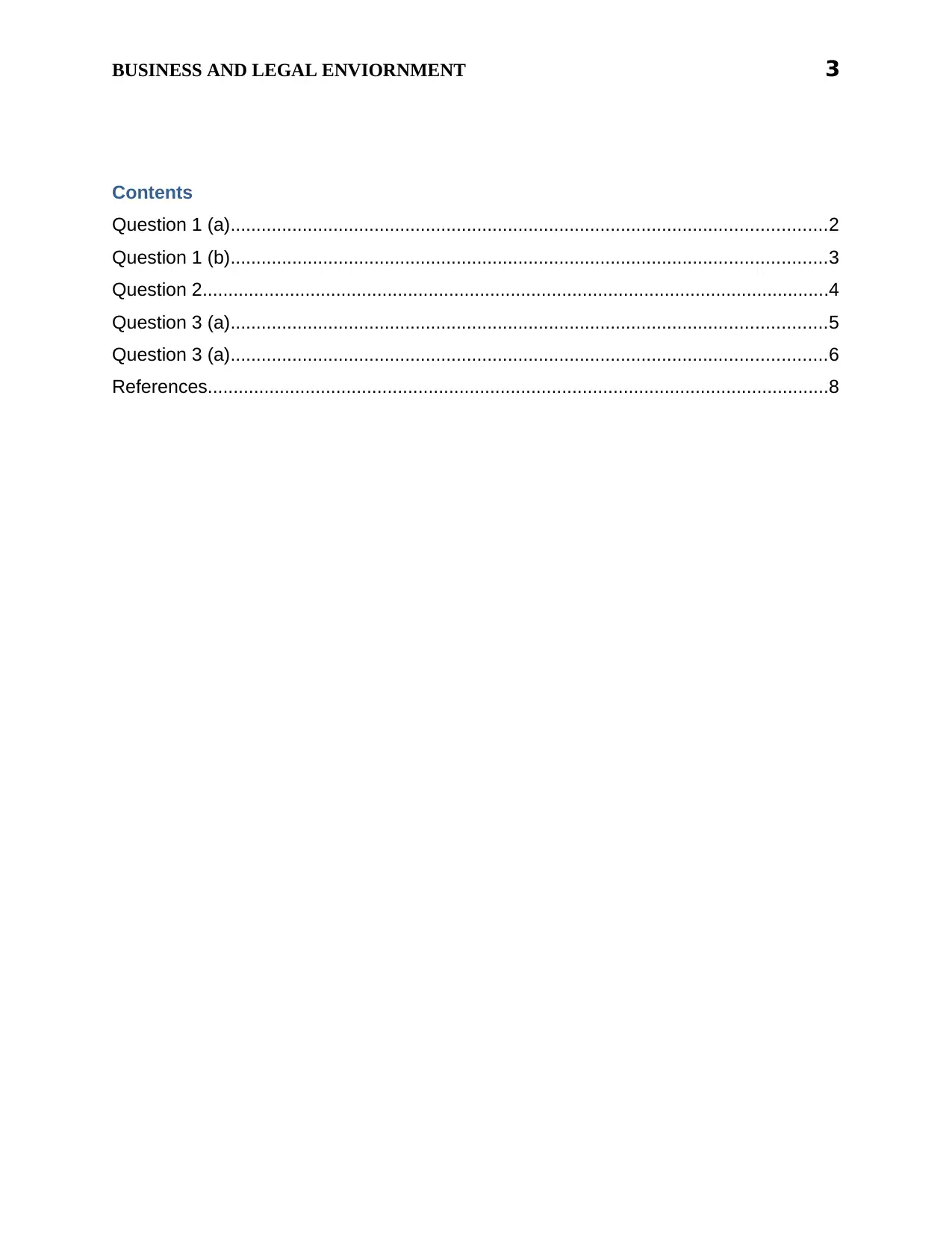
BUSINESS AND LEGAL ENVIORNMENT 3
Contents
Question 1 (a)....................................................................................................................2
Question 1 (b)....................................................................................................................3
Question 2..........................................................................................................................4
Question 3 (a)....................................................................................................................5
Question 3 (a)....................................................................................................................6
References.........................................................................................................................8
Contents
Question 1 (a)....................................................................................................................2
Question 1 (b)....................................................................................................................3
Question 2..........................................................................................................................4
Question 3 (a)....................................................................................................................5
Question 3 (a)....................................................................................................................6
References.........................................................................................................................8
Paraphrase This Document
Need a fresh take? Get an instant paraphrase of this document with our AI Paraphraser
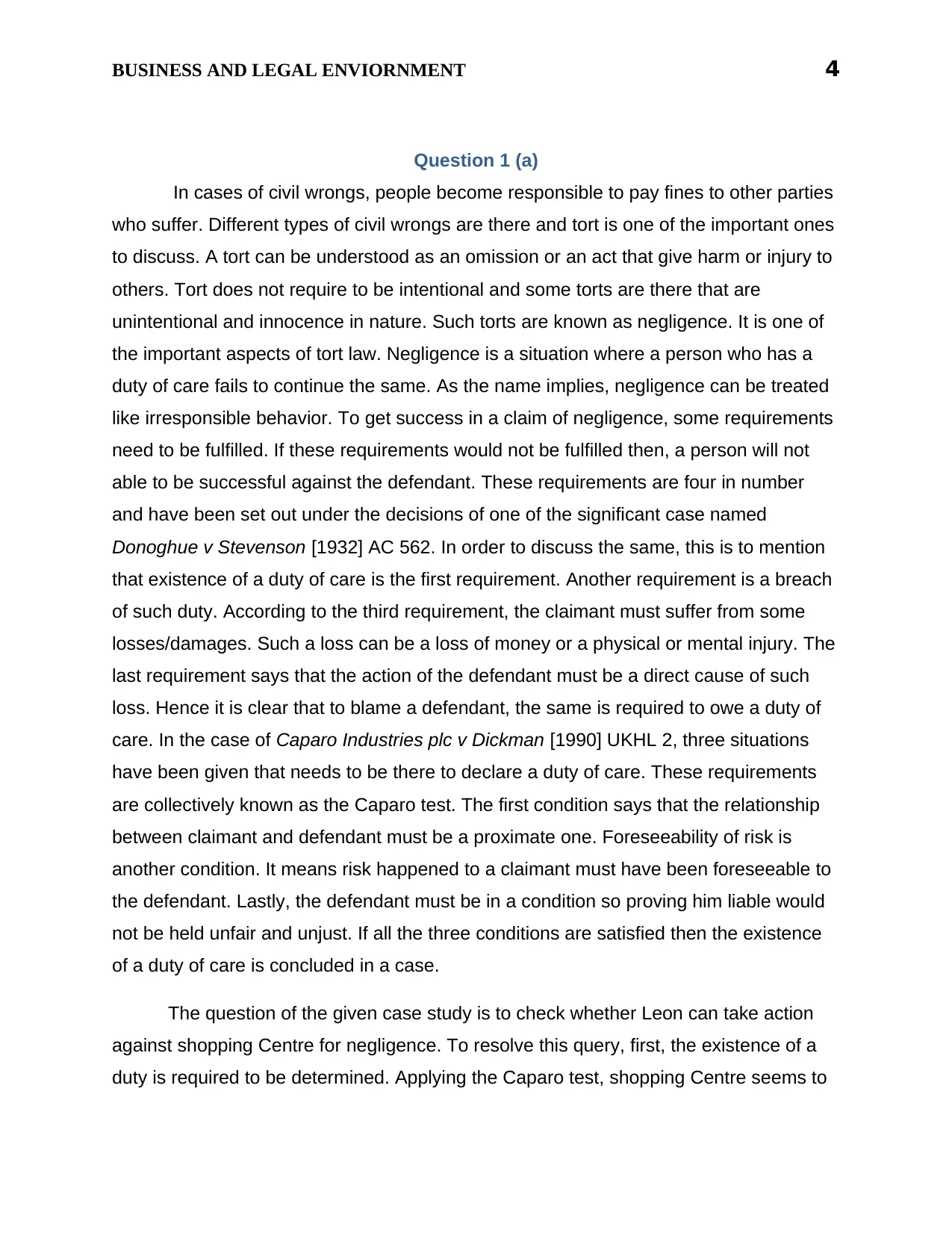
BUSINESS AND LEGAL ENVIORNMENT 4
Question 1 (a)
In cases of civil wrongs, people become responsible to pay fines to other parties
who suffer. Different types of civil wrongs are there and tort is one of the important ones
to discuss. A tort can be understood as an omission or an act that give harm or injury to
others. Tort does not require to be intentional and some torts are there that are
unintentional and innocence in nature. Such torts are known as negligence. It is one of
the important aspects of tort law. Negligence is a situation where a person who has a
duty of care fails to continue the same. As the name implies, negligence can be treated
like irresponsible behavior. To get success in a claim of negligence, some requirements
need to be fulfilled. If these requirements would not be fulfilled then, a person will not
able to be successful against the defendant. These requirements are four in number
and have been set out under the decisions of one of the significant case named
Donoghue v Stevenson [1932] AC 562. In order to discuss the same, this is to mention
that existence of a duty of care is the first requirement. Another requirement is a breach
of such duty. According to the third requirement, the claimant must suffer from some
losses/damages. Such a loss can be a loss of money or a physical or mental injury. The
last requirement says that the action of the defendant must be a direct cause of such
loss. Hence it is clear that to blame a defendant, the same is required to owe a duty of
care. In the case of Caparo Industries plc v Dickman [1990] UKHL 2, three situations
have been given that needs to be there to declare a duty of care. These requirements
are collectively known as the Caparo test. The first condition says that the relationship
between claimant and defendant must be a proximate one. Foreseeability of risk is
another condition. It means risk happened to a claimant must have been foreseeable to
the defendant. Lastly, the defendant must be in a condition so proving him liable would
not be held unfair and unjust. If all the three conditions are satisfied then the existence
of a duty of care is concluded in a case.
The question of the given case study is to check whether Leon can take action
against shopping Centre for negligence. To resolve this query, first, the existence of a
duty is required to be determined. Applying the Caparo test, shopping Centre seems to
Question 1 (a)
In cases of civil wrongs, people become responsible to pay fines to other parties
who suffer. Different types of civil wrongs are there and tort is one of the important ones
to discuss. A tort can be understood as an omission or an act that give harm or injury to
others. Tort does not require to be intentional and some torts are there that are
unintentional and innocence in nature. Such torts are known as negligence. It is one of
the important aspects of tort law. Negligence is a situation where a person who has a
duty of care fails to continue the same. As the name implies, negligence can be treated
like irresponsible behavior. To get success in a claim of negligence, some requirements
need to be fulfilled. If these requirements would not be fulfilled then, a person will not
able to be successful against the defendant. These requirements are four in number
and have been set out under the decisions of one of the significant case named
Donoghue v Stevenson [1932] AC 562. In order to discuss the same, this is to mention
that existence of a duty of care is the first requirement. Another requirement is a breach
of such duty. According to the third requirement, the claimant must suffer from some
losses/damages. Such a loss can be a loss of money or a physical or mental injury. The
last requirement says that the action of the defendant must be a direct cause of such
loss. Hence it is clear that to blame a defendant, the same is required to owe a duty of
care. In the case of Caparo Industries plc v Dickman [1990] UKHL 2, three situations
have been given that needs to be there to declare a duty of care. These requirements
are collectively known as the Caparo test. The first condition says that the relationship
between claimant and defendant must be a proximate one. Foreseeability of risk is
another condition. It means risk happened to a claimant must have been foreseeable to
the defendant. Lastly, the defendant must be in a condition so proving him liable would
not be held unfair and unjust. If all the three conditions are satisfied then the existence
of a duty of care is concluded in a case.
The question of the given case study is to check whether Leon can take action
against shopping Centre for negligence. To resolve this query, first, the existence of a
duty is required to be determined. Applying the Caparo test, shopping Centre seems to

BUSINESS AND LEGAL ENVIORNMENT 5
a held duty of care. Leon was the visitor of the mall and hence the management over
there had a proximate relationship with him. On a rainy day, it was expected that a
visitor could be injured because of the nature of the floor. In this manner, the risk of
injury was foreseeable and at last, the imposition of a duty of care to shopping Centre
would not be unfair/unjust. Shopping Centre did not take reasonable step to prevent the
injury and in this mode, the same breached the duty of care. Leon sustained a physical
injury because of the polished floor. It was a direct result of the negligence of the
shopping Centre. As it is a clear case of negligence and fulfills all the conditions of
Donoghue v Stevensons, hence, Leon can initiate action against Supermarket. He can
ask damages from shopping Centre.
Question 1 (b)
Not in every situation, the defendant can be held liable. Sometimes, he/she can
ask for some excuses and can be free from liability. Such excuses are known as
defenses. The very popular defense of negligence is contributory negligence that can
be used in cases where along with the defendant, claimant also fails to maintain a
degree of care and his /her actions contribute to injury or loss. The second important
defense is called volenti non fit injuria. Sometimes, claimant remains aware of the
possible risk hence proceed with the same. In such circumstances defendant can say
that claimant voluntarily adopted the risk and can take help of volenti non fit injuria. The
court may free the defendant from all the liability in such defense. Some other defenses
are also there, for instance, ex turpi cause and exclusion of liability. Ex turpi cause says
that defendant may not be held liable for immoral conducts (Agarwal, 2014). Further,
the later one says that a person may not be held liable where he/she excludes his/her
liability out of a breach.
In the presented case, the Supermarket is the defendant and the same cannot
rely on any defense. Leon did not contribute to injury and also not adopted the risk
knowingly. The first two defenses are not available in this manner. Further, the liability
was not excluded and the conduct of Leon was not an illegal one hence another two
defense also does not seems to be there for the shopping Centre.
a held duty of care. Leon was the visitor of the mall and hence the management over
there had a proximate relationship with him. On a rainy day, it was expected that a
visitor could be injured because of the nature of the floor. In this manner, the risk of
injury was foreseeable and at last, the imposition of a duty of care to shopping Centre
would not be unfair/unjust. Shopping Centre did not take reasonable step to prevent the
injury and in this mode, the same breached the duty of care. Leon sustained a physical
injury because of the polished floor. It was a direct result of the negligence of the
shopping Centre. As it is a clear case of negligence and fulfills all the conditions of
Donoghue v Stevensons, hence, Leon can initiate action against Supermarket. He can
ask damages from shopping Centre.
Question 1 (b)
Not in every situation, the defendant can be held liable. Sometimes, he/she can
ask for some excuses and can be free from liability. Such excuses are known as
defenses. The very popular defense of negligence is contributory negligence that can
be used in cases where along with the defendant, claimant also fails to maintain a
degree of care and his /her actions contribute to injury or loss. The second important
defense is called volenti non fit injuria. Sometimes, claimant remains aware of the
possible risk hence proceed with the same. In such circumstances defendant can say
that claimant voluntarily adopted the risk and can take help of volenti non fit injuria. The
court may free the defendant from all the liability in such defense. Some other defenses
are also there, for instance, ex turpi cause and exclusion of liability. Ex turpi cause says
that defendant may not be held liable for immoral conducts (Agarwal, 2014). Further,
the later one says that a person may not be held liable where he/she excludes his/her
liability out of a breach.
In the presented case, the Supermarket is the defendant and the same cannot
rely on any defense. Leon did not contribute to injury and also not adopted the risk
knowingly. The first two defenses are not available in this manner. Further, the liability
was not excluded and the conduct of Leon was not an illegal one hence another two
defense also does not seems to be there for the shopping Centre.
⊘ This is a preview!⊘
Do you want full access?
Subscribe today to unlock all pages.

Trusted by 1+ million students worldwide
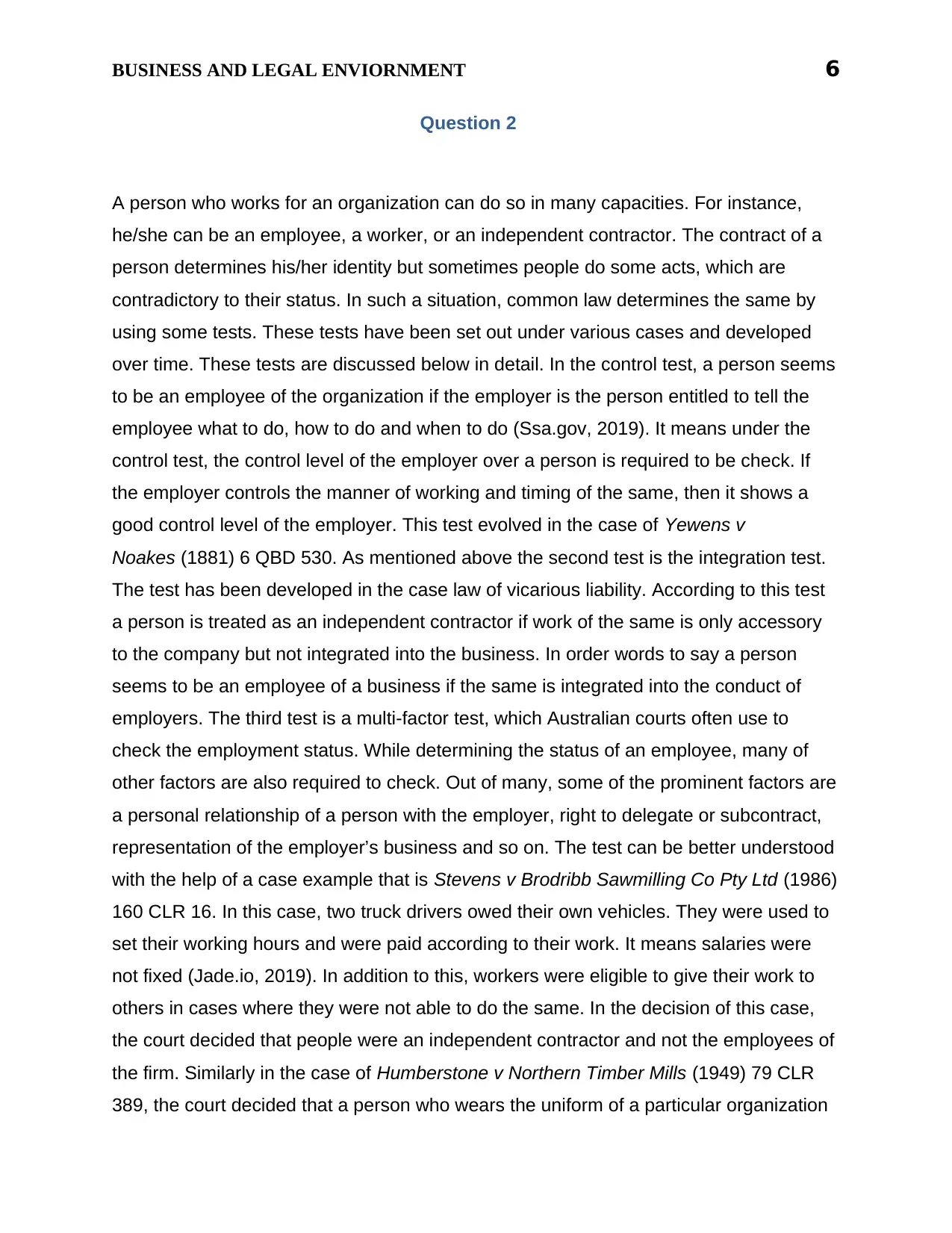
BUSINESS AND LEGAL ENVIORNMENT 6
Question 2
A person who works for an organization can do so in many capacities. For instance,
he/she can be an employee, a worker, or an independent contractor. The contract of a
person determines his/her identity but sometimes people do some acts, which are
contradictory to their status. In such a situation, common law determines the same by
using some tests. These tests have been set out under various cases and developed
over time. These tests are discussed below in detail. In the control test, a person seems
to be an employee of the organization if the employer is the person entitled to tell the
employee what to do, how to do and when to do (Ssa.gov, 2019). It means under the
control test, the control level of the employer over a person is required to be check. If
the employer controls the manner of working and timing of the same, then it shows a
good control level of the employer. This test evolved in the case of Yewens v
Noakes (1881) 6 QBD 530. As mentioned above the second test is the integration test.
The test has been developed in the case law of vicarious liability. According to this test
a person is treated as an independent contractor if work of the same is only accessory
to the company but not integrated into the business. In order words to say a person
seems to be an employee of a business if the same is integrated into the conduct of
employers. The third test is a multi-factor test, which Australian courts often use to
check the employment status. While determining the status of an employee, many of
other factors are also required to check. Out of many, some of the prominent factors are
a personal relationship of a person with the employer, right to delegate or subcontract,
representation of the employer’s business and so on. The test can be better understood
with the help of a case example that is Stevens v Brodribb Sawmilling Co Pty Ltd (1986)
160 CLR 16. In this case, two truck drivers owed their own vehicles. They were used to
set their working hours and were paid according to their work. It means salaries were
not fixed (Jade.io, 2019). In addition to this, workers were eligible to give their work to
others in cases where they were not able to do the same. In the decision of this case,
the court decided that people were an independent contractor and not the employees of
the firm. Similarly in the case of Humberstone v Northern Timber Mills (1949) 79 CLR
389, the court decided that a person who wears the uniform of a particular organization
Question 2
A person who works for an organization can do so in many capacities. For instance,
he/she can be an employee, a worker, or an independent contractor. The contract of a
person determines his/her identity but sometimes people do some acts, which are
contradictory to their status. In such a situation, common law determines the same by
using some tests. These tests have been set out under various cases and developed
over time. These tests are discussed below in detail. In the control test, a person seems
to be an employee of the organization if the employer is the person entitled to tell the
employee what to do, how to do and when to do (Ssa.gov, 2019). It means under the
control test, the control level of the employer over a person is required to be check. If
the employer controls the manner of working and timing of the same, then it shows a
good control level of the employer. This test evolved in the case of Yewens v
Noakes (1881) 6 QBD 530. As mentioned above the second test is the integration test.
The test has been developed in the case law of vicarious liability. According to this test
a person is treated as an independent contractor if work of the same is only accessory
to the company but not integrated into the business. In order words to say a person
seems to be an employee of a business if the same is integrated into the conduct of
employers. The third test is a multi-factor test, which Australian courts often use to
check the employment status. While determining the status of an employee, many of
other factors are also required to check. Out of many, some of the prominent factors are
a personal relationship of a person with the employer, right to delegate or subcontract,
representation of the employer’s business and so on. The test can be better understood
with the help of a case example that is Stevens v Brodribb Sawmilling Co Pty Ltd (1986)
160 CLR 16. In this case, two truck drivers owed their own vehicles. They were used to
set their working hours and were paid according to their work. It means salaries were
not fixed (Jade.io, 2019). In addition to this, workers were eligible to give their work to
others in cases where they were not able to do the same. In the decision of this case,
the court decided that people were an independent contractor and not the employees of
the firm. Similarly in the case of Humberstone v Northern Timber Mills (1949) 79 CLR
389, the court decided that a person who wears the uniform of a particular organization
Paraphrase This Document
Need a fresh take? Get an instant paraphrase of this document with our AI Paraphraser
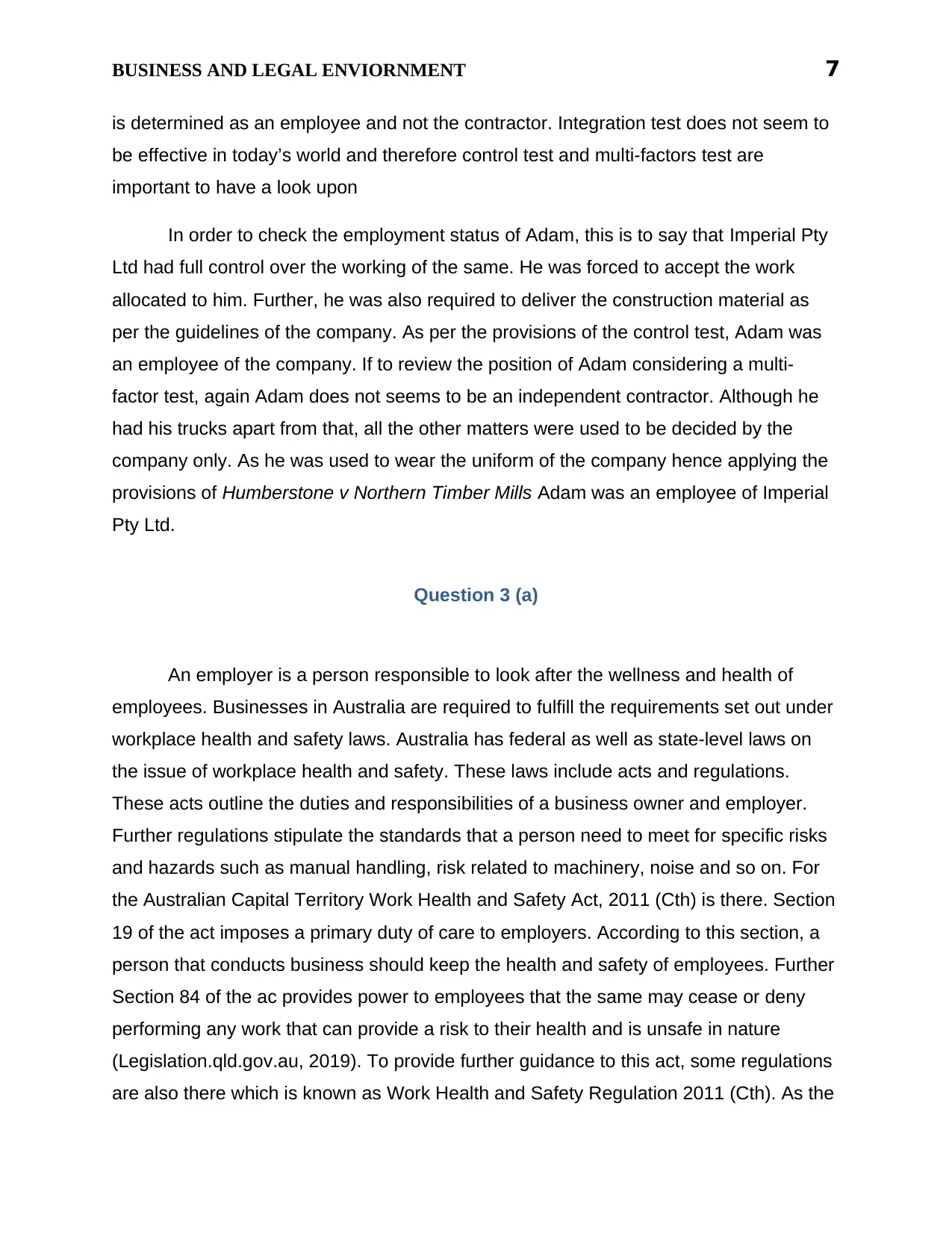
BUSINESS AND LEGAL ENVIORNMENT 7
is determined as an employee and not the contractor. Integration test does not seem to
be effective in today’s world and therefore control test and multi-factors test are
important to have a look upon
In order to check the employment status of Adam, this is to say that Imperial Pty
Ltd had full control over the working of the same. He was forced to accept the work
allocated to him. Further, he was also required to deliver the construction material as
per the guidelines of the company. As per the provisions of the control test, Adam was
an employee of the company. If to review the position of Adam considering a multi-
factor test, again Adam does not seems to be an independent contractor. Although he
had his trucks apart from that, all the other matters were used to be decided by the
company only. As he was used to wear the uniform of the company hence applying the
provisions of Humberstone v Northern Timber Mills Adam was an employee of Imperial
Pty Ltd.
Question 3 (a)
An employer is a person responsible to look after the wellness and health of
employees. Businesses in Australia are required to fulfill the requirements set out under
workplace health and safety laws. Australia has federal as well as state-level laws on
the issue of workplace health and safety. These laws include acts and regulations.
These acts outline the duties and responsibilities of a business owner and employer.
Further regulations stipulate the standards that a person need to meet for specific risks
and hazards such as manual handling, risk related to machinery, noise and so on. For
the Australian Capital Territory Work Health and Safety Act, 2011 (Cth) is there. Section
19 of the act imposes a primary duty of care to employers. According to this section, a
person that conducts business should keep the health and safety of employees. Further
Section 84 of the ac provides power to employees that the same may cease or deny
performing any work that can provide a risk to their health and is unsafe in nature
(Legislation.qld.gov.au, 2019). To provide further guidance to this act, some regulations
are also there which is known as Work Health and Safety Regulation 2011 (Cth). As the
is determined as an employee and not the contractor. Integration test does not seem to
be effective in today’s world and therefore control test and multi-factors test are
important to have a look upon
In order to check the employment status of Adam, this is to say that Imperial Pty
Ltd had full control over the working of the same. He was forced to accept the work
allocated to him. Further, he was also required to deliver the construction material as
per the guidelines of the company. As per the provisions of the control test, Adam was
an employee of the company. If to review the position of Adam considering a multi-
factor test, again Adam does not seems to be an independent contractor. Although he
had his trucks apart from that, all the other matters were used to be decided by the
company only. As he was used to wear the uniform of the company hence applying the
provisions of Humberstone v Northern Timber Mills Adam was an employee of Imperial
Pty Ltd.
Question 3 (a)
An employer is a person responsible to look after the wellness and health of
employees. Businesses in Australia are required to fulfill the requirements set out under
workplace health and safety laws. Australia has federal as well as state-level laws on
the issue of workplace health and safety. These laws include acts and regulations.
These acts outline the duties and responsibilities of a business owner and employer.
Further regulations stipulate the standards that a person need to meet for specific risks
and hazards such as manual handling, risk related to machinery, noise and so on. For
the Australian Capital Territory Work Health and Safety Act, 2011 (Cth) is there. Section
19 of the act imposes a primary duty of care to employers. According to this section, a
person that conducts business should keep the health and safety of employees. Further
Section 84 of the ac provides power to employees that the same may cease or deny
performing any work that can provide a risk to their health and is unsafe in nature
(Legislation.qld.gov.au, 2019). To provide further guidance to this act, some regulations
are also there which is known as Work Health and Safety Regulation 2011 (Cth). As the
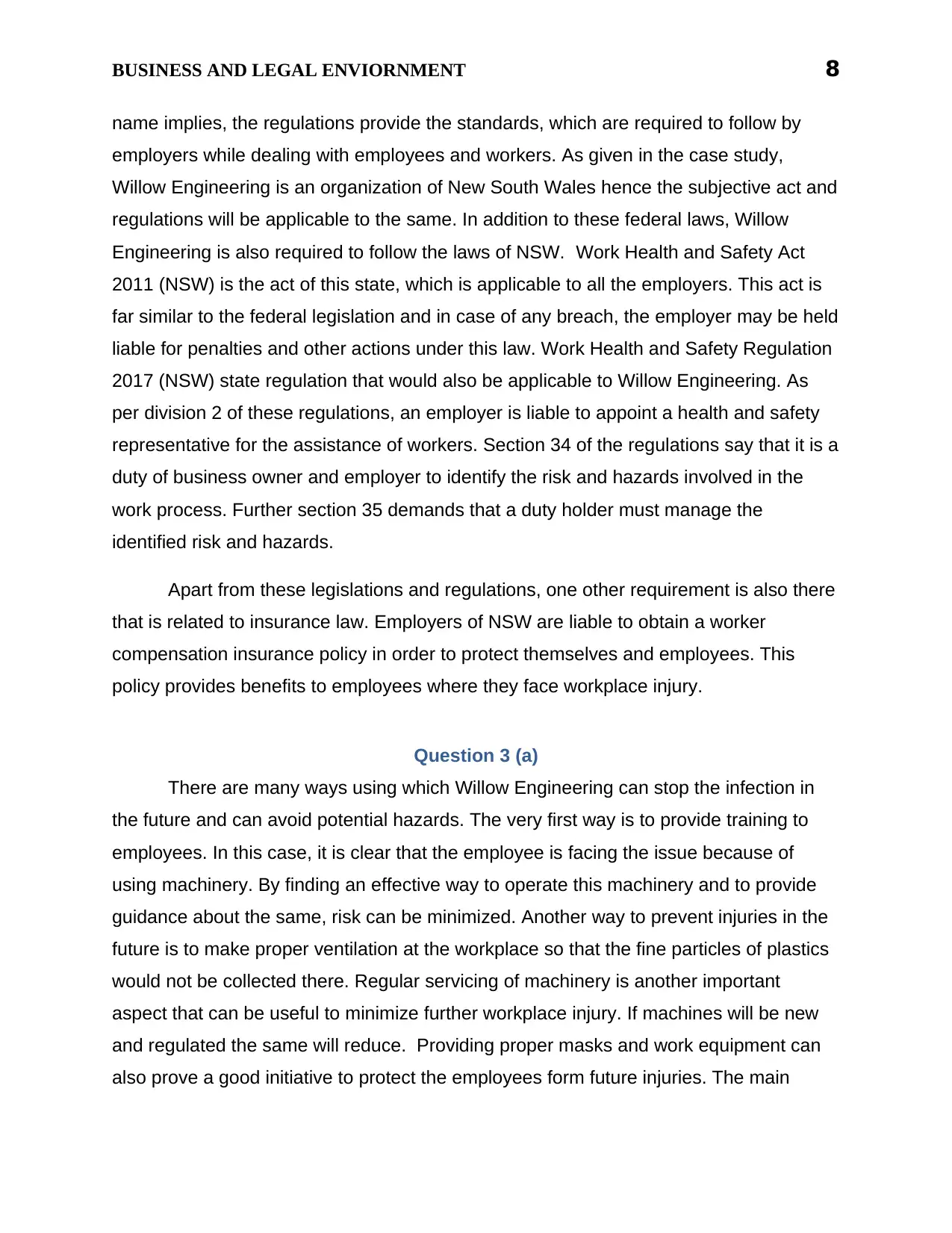
BUSINESS AND LEGAL ENVIORNMENT 8
name implies, the regulations provide the standards, which are required to follow by
employers while dealing with employees and workers. As given in the case study,
Willow Engineering is an organization of New South Wales hence the subjective act and
regulations will be applicable to the same. In addition to these federal laws, Willow
Engineering is also required to follow the laws of NSW. Work Health and Safety Act
2011 (NSW) is the act of this state, which is applicable to all the employers. This act is
far similar to the federal legislation and in case of any breach, the employer may be held
liable for penalties and other actions under this law. Work Health and Safety Regulation
2017 (NSW) state regulation that would also be applicable to Willow Engineering. As
per division 2 of these regulations, an employer is liable to appoint a health and safety
representative for the assistance of workers. Section 34 of the regulations say that it is a
duty of business owner and employer to identify the risk and hazards involved in the
work process. Further section 35 demands that a duty holder must manage the
identified risk and hazards.
Apart from these legislations and regulations, one other requirement is also there
that is related to insurance law. Employers of NSW are liable to obtain a worker
compensation insurance policy in order to protect themselves and employees. This
policy provides benefits to employees where they face workplace injury.
Question 3 (a)
There are many ways using which Willow Engineering can stop the infection in
the future and can avoid potential hazards. The very first way is to provide training to
employees. In this case, it is clear that the employee is facing the issue because of
using machinery. By finding an effective way to operate this machinery and to provide
guidance about the same, risk can be minimized. Another way to prevent injuries in the
future is to make proper ventilation at the workplace so that the fine particles of plastics
would not be collected there. Regular servicing of machinery is another important
aspect that can be useful to minimize further workplace injury. If machines will be new
and regulated the same will reduce. Providing proper masks and work equipment can
also prove a good initiative to protect the employees form future injuries. The main
name implies, the regulations provide the standards, which are required to follow by
employers while dealing with employees and workers. As given in the case study,
Willow Engineering is an organization of New South Wales hence the subjective act and
regulations will be applicable to the same. In addition to these federal laws, Willow
Engineering is also required to follow the laws of NSW. Work Health and Safety Act
2011 (NSW) is the act of this state, which is applicable to all the employers. This act is
far similar to the federal legislation and in case of any breach, the employer may be held
liable for penalties and other actions under this law. Work Health and Safety Regulation
2017 (NSW) state regulation that would also be applicable to Willow Engineering. As
per division 2 of these regulations, an employer is liable to appoint a health and safety
representative for the assistance of workers. Section 34 of the regulations say that it is a
duty of business owner and employer to identify the risk and hazards involved in the
work process. Further section 35 demands that a duty holder must manage the
identified risk and hazards.
Apart from these legislations and regulations, one other requirement is also there
that is related to insurance law. Employers of NSW are liable to obtain a worker
compensation insurance policy in order to protect themselves and employees. This
policy provides benefits to employees where they face workplace injury.
Question 3 (a)
There are many ways using which Willow Engineering can stop the infection in
the future and can avoid potential hazards. The very first way is to provide training to
employees. In this case, it is clear that the employee is facing the issue because of
using machinery. By finding an effective way to operate this machinery and to provide
guidance about the same, risk can be minimized. Another way to prevent injuries in the
future is to make proper ventilation at the workplace so that the fine particles of plastics
would not be collected there. Regular servicing of machinery is another important
aspect that can be useful to minimize further workplace injury. If machines will be new
and regulated the same will reduce. Providing proper masks and work equipment can
also prove a good initiative to protect the employees form future injuries. The main
⊘ This is a preview!⊘
Do you want full access?
Subscribe today to unlock all pages.

Trusted by 1+ million students worldwide
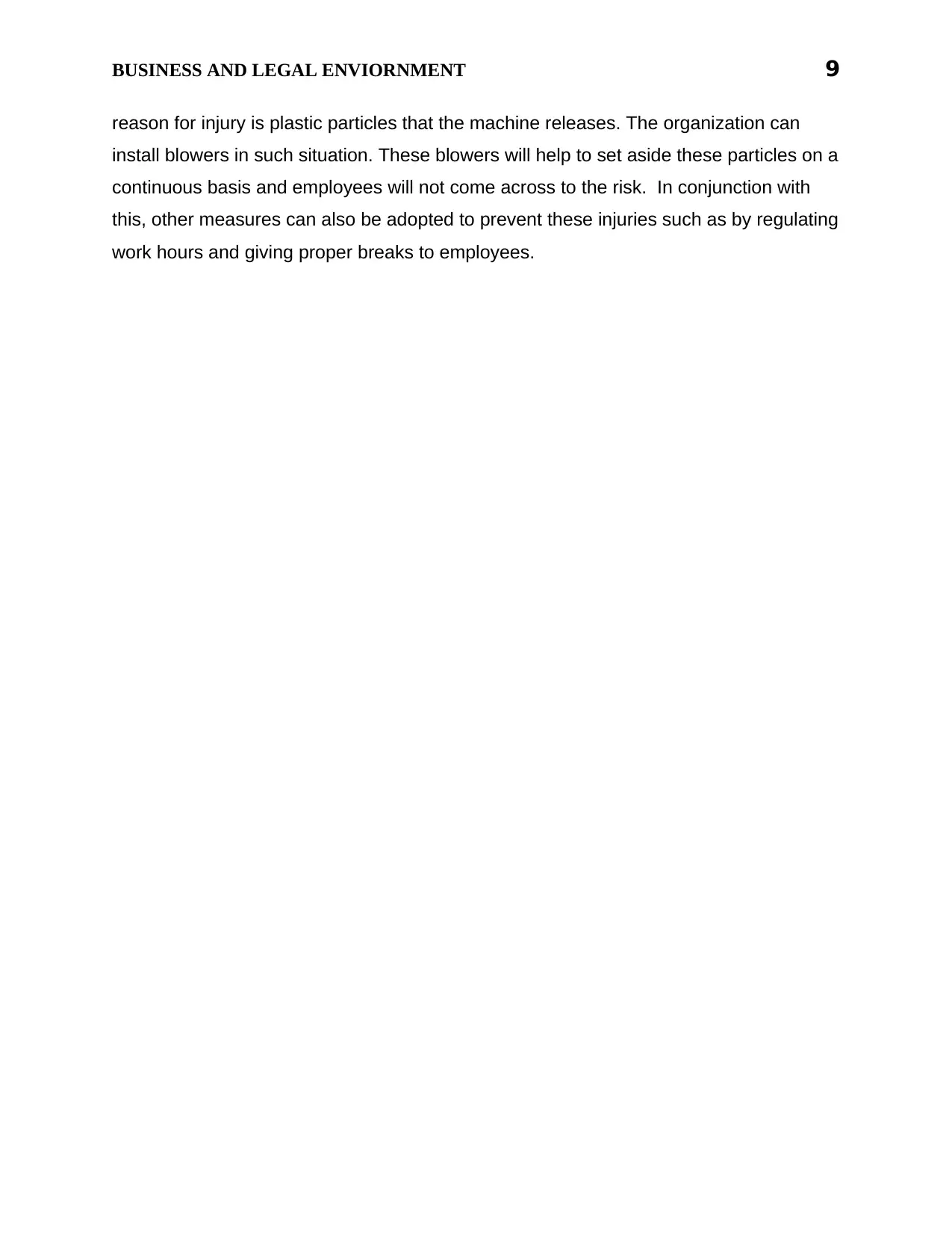
BUSINESS AND LEGAL ENVIORNMENT 9
reason for injury is plastic particles that the machine releases. The organization can
install blowers in such situation. These blowers will help to set aside these particles on a
continuous basis and employees will not come across to the risk. In conjunction with
this, other measures can also be adopted to prevent these injuries such as by regulating
work hours and giving proper breaks to employees.
reason for injury is plastic particles that the machine releases. The organization can
install blowers in such situation. These blowers will help to set aside these particles on a
continuous basis and employees will not come across to the risk. In conjunction with
this, other measures can also be adopted to prevent these injuries such as by regulating
work hours and giving proper breaks to employees.
Paraphrase This Document
Need a fresh take? Get an instant paraphrase of this document with our AI Paraphraser

BUSINESS AND LEGAL ENVIORNMENT 10
References
Agarwal, A. (2014). General Defenses In Torts. Retrieved From:
https://www.lawctopus.com/academike/general-defenses-in-torts/
Caparo Industries plc v Dickman [1990] UKHL 2
Donoghue v Stevenson [1932] AC 562
Humberstone v Northern Timber Mills (1949) 79 CLR 389
Jade.io. (2019). High Court Of Australia. Retrieved From: https://jade.io/article/67255
Legislation.qld.gov.au. (2019). Work Health and Safety Act 2011. Retrieved From:
https://www.legislation.qld.gov.au/view/html/inforce/current/act-2011-018#sec.84
Ssa.gov. (2019). How To Apply The Common Law Control Test In Determining An
Employer/Employee Relationship. Retrieved From:
https://www.ssa.gov/section218training/advanced_course_10.htm#4
Stevens v Brodribb Sawmilling Co Pty Ltd (1986) 160 CLR 16
Work Health and Safety Act 2011 (Cth)
Work Health and Safety Act 2011 (NSW)
Work Health and Safety Regulation 2011 (Cth)
Work Health and Safety Regulation 2017 (NSW)
Yewens v Noakes (1881) 6 QBD 530
References
Agarwal, A. (2014). General Defenses In Torts. Retrieved From:
https://www.lawctopus.com/academike/general-defenses-in-torts/
Caparo Industries plc v Dickman [1990] UKHL 2
Donoghue v Stevenson [1932] AC 562
Humberstone v Northern Timber Mills (1949) 79 CLR 389
Jade.io. (2019). High Court Of Australia. Retrieved From: https://jade.io/article/67255
Legislation.qld.gov.au. (2019). Work Health and Safety Act 2011. Retrieved From:
https://www.legislation.qld.gov.au/view/html/inforce/current/act-2011-018#sec.84
Ssa.gov. (2019). How To Apply The Common Law Control Test In Determining An
Employer/Employee Relationship. Retrieved From:
https://www.ssa.gov/section218training/advanced_course_10.htm#4
Stevens v Brodribb Sawmilling Co Pty Ltd (1986) 160 CLR 16
Work Health and Safety Act 2011 (Cth)
Work Health and Safety Act 2011 (NSW)
Work Health and Safety Regulation 2011 (Cth)
Work Health and Safety Regulation 2017 (NSW)
Yewens v Noakes (1881) 6 QBD 530
1 out of 11
Related Documents
Your All-in-One AI-Powered Toolkit for Academic Success.
+13062052269
info@desklib.com
Available 24*7 on WhatsApp / Email
![[object Object]](/_next/static/media/star-bottom.7253800d.svg)
Unlock your academic potential
Copyright © 2020–2025 A2Z Services. All Rights Reserved. Developed and managed by ZUCOL.





